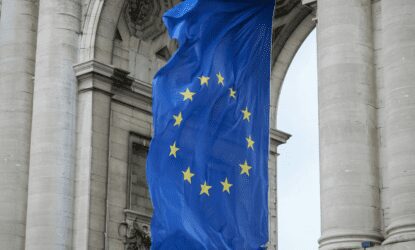“A well-structured ESG budget isn’t an expense—it’s an investment in resilience, reputation, and long-term value.”
For many sustainability teams, the annual budgeting cycle can feel overwhelming. You face pressure from the board to demonstrate progress, from regulators to meet new standards, and from employees to create meaningful impact. But behind every successful ESG programme is not just a spreadsheet—it is your story: a journey of aligning your values, resources, and ambitions to deliver real results.
Nexio Projects is a leading sustainability consultancy in the Netherlands, providing expert sustainability services and ESG advisory to help organisations tackle complex challenges and achieve ambitious climate goals.
Named one of the top 10 boutique ESG and sustainability strategy consultancies worldwide by Verdantix, our team of certified sustainability consultants, ESG consultants, and environmental consultants brings clarity across reporting, strategy, and implementation.
With over 400 clients, 1000+ projects across 25+ sectors and 20+ countries, we are a B Corp, an EcoVadis strategic partner since 2018, and your trusted partner in turning sustainability targets into impact.
We have seen firsthand how the right ESG budget transforms good intentions into lasting impact. It is not about chasing every trend or ticking every box. It is about building a financial plan that reflects your organisation’s unique sustainability journey and sets you up for measurable results.
When does an investment start generating a return, and how does this timing impact an organisation’s strategy? Whether you are evaluating long-term value or planning an exit, understanding this turning point is crucial.
Imagine a sustainability team at the start of their financial year. Their inbox is full of requests:
- The facilities manager wants to upgrade lighting for energy efficiency.
- HR is advocating for a new diversity and inclusion programme.
- Legal is flagging new reporting requirements.
- The CEO wants to see “real impact”—but within a sensible budget.
How do you bring all these threads together into a coherent, actionable plan?
The strategic imperative of ESG budgeting
In 2024, 92% of FTSE 100 companies publicly disclosed ESG budgets—yet 67% struggled with misallocated resources. With the EU Corporate Sustainability Reporting Directive (CSRD) being enforced to some extent and the UK’s Sustainability Disclosure Requirements (SDR) accelerating, ESG budgeting has shifted from voluntary to vital.
Building a high-Level ESG budget: Categories & investment rationale
Step 1: Defining what matters most
The first step is clarity. Before numbers come into play, successful teams gather stakeholders to answer:
- What are our biggest sustainability risks and opportunities?
- Which ESG issues matter most to our business and stakeholders?
- Where can we create the most value—environmental, social, and financial?
The right way to start is to understand your organisation’s vision and where it wants to go. This often means running a materiality assessment or stakeholder workshop. It is a chance for teams to listen, prioritise, and set a clear direction. The outcome is not a list of expenses; it is a roadmap of priorities that will shape the budget.
Want to learn more about double materiality assessments? Check out our on-demand video by sustainability experts about tips and best practices.

Step 2: Building the budget framework
With priorities in hand, the team can start mapping out the budget. Rather than dividing funds equally or reacting to the loudest voices, they create categories that reflect their strategy. Typically, these are:
- Environmental: Projects like energy efficiency, waste reduction, or climate risk assessments.
- Social: Initiatives for employee wellbeing, community engagement, or diversity and inclusion.
- Governance: Investments in compliance, reporting tools, or ethics training.
Each category gets its own “envelope” of funding, sized according to its importance and potential impact. The team does not just ask, “How much can we spend?” but “What do we want to achieve, and what will it take?”
Step 3: Mapping the year
The ROI from ESG budgeting comes into play at multiple stages depending on how well ESG is integrated into the business strategy. According to McKinsey, the returns can be summarised as follows:
Early ROI: Cost reductions and risk mitigation
Investments such as energy efficiency upgrades, waste reduction, and improved resource use generate relatively quick, measurable returns through operational cost savings and risk reduction. Companies can often see ROI within the first few years by avoiding rising energy costs, regulatory fines, and supply chain disruptions.
Mid-to-long-term ROI: Growth and value creation
As ESG becomes central to business strategy, companies that excel both financially and in ESG performance (“triple outperformers”) achieve higher shareholder returns over three to five years. This growth is driven by top-line increases from new products or markets, improved access to capital, customer loyalty, premium pricing on sustainable products, and optimised asset allocation.
Strategic ROI: Avoided costs and future readiness
Proactive ESG budgeting protects against eroding value caused by accumulating regulatory, reputational, and resource risks. It helps avoid stranded assets and positions companies to seize opportunities arising from regulatory or consumer demand shifts. The market rewards companies leading on ESG with a premium that mainly materialises over the medium to long term.
In short, companies that budget deliberately for ESG and track outcomes as part of overall value creation tend to achieve the best returns. Immediate ROI often appears in cost and risk reductions, while more substantial returns emerge over the medium to long term through growth, resilience, and sustained competitive advantage.
This rhythm keeps the team agile, responsive, and focused on outcomes—not just activities.
As summer approaches and the third quarter unfolds, many sustainability teams find themselves with a portion of the ESG budget still unallocated or left over from earlier cautious spending. Rather than rushing to deploy these funds or letting them sit idle, this period offers a strategic opportunity to reassess and maximise impact. Teams should start by reviewing the progress of ongoing initiatives and identifying any projects that are exceeding expectations and could benefit from additional investment. It is also an ideal time to revisit stakeholder feedback gathered earlier in the year—perhaps there are emerging needs from employees, communities, or suppliers that were not initially prioritised but now present high-impact opportunities.
A best practice is to convene a mid-year budget review session, involving both finance and sustainability leads, to transparently discuss where funds can be most effectively reallocated. This might mean scaling up successful pilots, accelerating the rollout of a promising technology, or addressing unforeseen regulatory requirements.
Importantly, any reallocation should still align with the organisation’s ESG priorities and be supported by clear KPIs to ensure accountability. By taking a thoughtful, data-driven approach to leftover budget in the summer, sustainability teams can ensure every pound is directed towards initiatives that drive measurable progress and set the stage for a strong finish to the year.
Key reasons why budgeting ESG is essential
- Value creation through five key levers: McKinsey identifies five main ways ESG frameworks drive value: facilitating top-line growth, reducing costs, minimising regulatory and legal interventions, increasing employee productivity, and optimising investment and capital expenditure. Budgeting ensures initiatives across these levers are fully resourced and aligned with business goals.
- Cost reduction and risk management: Effective ESG budgeting helps control risks such as regulatory fines, resource price volatility, and stranded assets. Companies that invest proactively in sustainability strategies can achieve significant cost savings and improved resource efficiency, sometimes increasing operating profits by up to 60%.
- Capital allocation and long-term investment: Dedicated ESG budgeting enables companies to direct capital towards future-proof, sustainable opportunities (such as renewables or waste reduction) and to avoid investments that may become liabilities due to environmental and regulatory shifts. Delaying action can erode value over time.
- Meeting investor and stakeholder expectations: Investors increasingly scrutinise ESG performance. Allocating clear budgets signals strategic commitment, meets market demand for sustainability, and supports favourable access to capital.
- Regulatory compliance and strategic freedom: A structured ESG budget helps companies anticipate and act proactively in response to upcoming regulations, thereby reducing compliance costs and enhancing operational flexibility.
In summary, budgeting is the foundation of a credible and effective ESG planning. Without clear budget allocation, ESG initiatives become fragmented and reactive—missing opportunities for value creation, resilience, and competitive advantage that McKinsey highlights as central to next-generation business leadership.
What Nexio Projects can offer sustainability teams
1. Clear strategic alignment
ESG budgets must be directly tied to overall business strategy, not treated as a side initiative. This ensures that investments support top-line growth and resilience, positioning ESG as both a value driver and risk mitigator rather than a simple compliance exercise.
2. Prioritised value levers
Companies should map their ESG spending to the areas with the highest ROI potential, such as energy efficiency, sustainable supply chains, new “green” product lines, or initiatives that safeguard reputation and regulatory compliance. This means allocating budgets where they most directly reduce costs, unlock new markets, or differentiate the brand.
3. Measurable outcomes and sustainability KPIs
To justify spending and capture ROI, firms need robust processes for tracking outcomes against clear key performance indicators (KPIs)—including both financial and ESG-related metrics. This enables ongoing optimisation, provides the basis for transparent reporting, and satisfies increasingly stringent investor expectations for evidence-based ESG performance.
4. Integrated risk and opportunity assessment
Effective ESG budgeting should include a comprehensive assessment of both risks (e.g., regulatory, supply chain, reputational) and value creation opportunities. Allocating funds to anticipate, mitigate, or capitalise on these elements strengthens the ROI profile and future-proofs the company’s strategy.
5. Dynamic capital allocation and feedback loops
ESG spending should be adaptable, shifting as priorities evolve, best practices emerge, and external conditions (such as regulations or stakeholder expectations) change. Companies that institutionalise feedback loops; using data to reallocate resources for the highest-impact ESG initiatives; outperform their peers and capture superior long-term ROI.
Conclusion: Your ESG budget as a story of progress
Numbers matter, but the real power of an ESG budget lies in the story it tells. It is the story of a team that listened, prioritised, and acted. Of a business that turned ambition into action, and action into impact. By focusing on these elements, companies are best positioned to ensure their ESG budgets deliver measurable, strategic, and sustainable ROI, rather than becoming fragmented or reactive expenditures. This disciplined, outcome-focused approach is what distinguishes leading organisations on ESG value creation.
If you are ready to write your own sustainability leadership story, Nexio Projects is here to help. Contact us to discuss your ESG budget and the next steps for the second half of 2025 and in the coming years.
Interested in regular ESG updates? Subscribe to our newsletter and join the community!
References:
- European Commission, 2021. EU Budget: At least 30% of expenditure to support climate objectives. Brussels: European Commission.
- European Commission, 2023. EU Green Budgeting Reference Framework. Brussels: DG Economic and Financial Affairs.
- World Economic Forum, 2020. Diversity, Equity and Inclusion 4.0: A Toolkit for Leaders to Accelerate Social Progress. Geneva: WEF.
- United Nations Development Programme, 2015. Sustainable Development Goals. New York: UNDP.
- Global Reporting Initiative, 2021. Consolidated Set of GRI Standards 2021. Amsterdam: GRI.
- European Commission, 2021. Sustainable Finance Disclosure Regulation (SFDR): Regulation (EU) 2019/2088. Brussels: European Commission.
- McKinsey & Company, “More than values: The value-based sustainability reporting that investors want,” 2023. Available at: https://www.mckinsey.com/~/media/McKinsey/Business%20Functions/Sustainability/Our%20Insights/More%20than%20values%20The%20value%20based%20sustainability%20reporting%20that%20investors%20want/More%20than%20values-VF.pdf [Accessed 13 Aug. 2025].
- McKinsey & Company, “Linking ESG initiatives to financial performance,” 2023. Available at: https://www.mckinsey.com/capabilities/strategy-and-corporate-finance/our-insights/investors-want-to-hear-from-companies-about-the-value-of-sustainability [Accessed 13 Aug. 2025].











